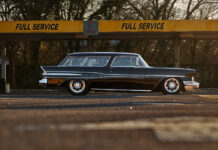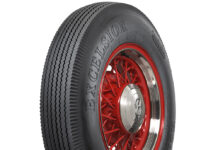Performance Oftentimes Boils Down to Power to Weight … Such as This 1948 Simca
By Louis Kimery – Photography by the Author
It’s usually considered sound wisdom to not spend too much valuable time revisiting the past. While that’s probably good advice to be headed under most circumstances, there are exceptions. For instance, we hot rodders have a special way of looking in the rearview mirror that often creates something new from our fond memories of yesteryear.

A case in point would be John Callies’ latest project, a spiritual rehash of his well-known ’70s build of a vintage 1937 Simca coupe. During the “Me” decade, whenever John climbed behind the wheel of his Franco-American hot rod, most other cars broke out into a cold sweat. It seems the go-kart–like handling prowess and pure hot rod acceleration of the diminutive car could easily outshine most sports cars of the day. As a result, John acquired a feared reputation among the string-back gloved set wherever he went. On one occasion, an embarrassed MG club hosting a Southern California hill climb asked John to take his micro machine home after he made two blistering runs through the course. The Simca was also a 10-second, 130-mph drag car, making it a true all-purpose street rod.

The secret sauce of the Simca’s devious deeds lay in its obvious light weight, and the ultrarare 303ci Pontiac V-8 engine that was originally conceived of for use in the Trans-Am racing series. There were all of 25 such low-deck engines made, all equipped with Pontiac’s infamous Ram Air V heads. John was a Pontiac engineer at the time, so he had a direct connection to the rare engine combination. Equipped with a quartet of Weber 48 IDA carbs, a dose of nitrous oxide, and some handmade porcelain headers, the motor became a powerful showpiece in the Simca’s tiny engine bay. The mill was mated to a Muncie M22 four-speed transmission, while a narrowed 1957 Oldsmobile rearend running 4.30 gears allowed some serious rubber to fit between the widened rear fenders. The coupe used the front suspension from a 1952 MG, and the gold leaf “303” lettered onto the coupe’s doors made the Simca instantly recognizable.

The Simca spent a few years making NSRA street rod events from Lodi, California, to Detroit, and all points in between, before arriving at the 1976 Tulsa Street Rod Nationals. At that event, the tiny hot rod collected First Place in the StreetKhana competition, and Third Place in the Street Sweeper contest, while simultaneously snagging the Best Engineered award in the owner-built category from the NSRA brass.

Eventually, John went to work at the GM proving grounds in Mesa, Arizona, where he spent his time preparing specialty vehicles. He would go on to become the first-ever director of Pontiac Motorsports where job one was to make the then-new Fiero a capable pace car for the upcoming 1984 Indianapolis 500. Since the production Fiero was assembled primarily with over-the-counter economy car components, with a 92hp Iron Duke four-banger, John had his work cut out for him. Pace car duty demanded that the vehicle be capable of lasting throughout the entire 500-mile race. So, within a seven-month time frame, John and his crew turned the Fiero into a Super Duty 4–powered pace car, boosting the output into the 250-plus horsepower range. The go-fast formula worked, as John was not only able to reach the required speeds at the Brickyard but the car averaged 136 mph over four laps. Thus besting the performance of the Corvette Pace Car from the previous year. John was then chosen to drive the pace car during the Memorial Day classic, and after a long day of starting the race, and the ensuing 13 caution flags that were incurred, both the car and driver proved their worth as the Fiero showed itself to be a worthy Indy 500 pace car.

John served as Pontiac’s motorsports director throughout the ’80s and ’90s. He was responsible for the engine, aerodynamics, and chassis development programs for Pontiac racers from NASCAR to NHRA as well as a full factory-backed IMSA GTU/GTP program. John also took Don Prudhomme’s Firebird Funny Car to the wind tunnel for groundbreaking aerodynamic research, and he worked with Butch Leal to develop the aero hood scoop that would soon become standard equipment on Pro Stock race cars. When he left Pontiac after 20 years he started his own company, Callies Crankshaft. Later, John sold the company and relocated to Memphis, Tennessee, to manage Lunati Cams, as it transitioned to new ownership. After the Lunati gig, John worked with the Camshaft Machine Company and then became a partner with Morel Lifters, which continues to this day. Morel is the exclusive lifter supplier to Hendrick Motorsports and provides race teams as well as the performance aftermarket industry with their private label roller lifters for racing engines.

But something was missing. John wanted to get in on the fun of driving his own hot rods again. So, he focused on his own personal street rod project. He became an active member of the Memphis Street Rods and he got involved with the East Coast Timing Association’s paved mile, high-speed record events, in pursuit of 200 mph in a street rod. After setting multiple ECTA records with a street-driven car, John wanted to try a simpler approach. A small car/big horsepower combination felt like just the ticket. Was it finally time for a 303 Simca Redux?



As much fun as the old 303 Simca was, 50 years is a lot of water under the bridge. No longer would John find an original-steel Simca in the classified ads for all of $25, so the planned construction process called for fresh hardware throughout the build of the new-age Simca. Once John made the decision to reincarnate his old hot rod, the first thing he did was to consult with Matt Jones at Art Morrison Enterprises (AME) about constructing a custom chassis that utilizes AME’s newly designed Multilink IRS. The IRS features a Strange Engineering 10-½-inch rear housing 4.11 gears. The chassis is also equipped with independent front suspension, and a rack-and-pinion steering assembly and Brembo six-piston disc brakes in front and four-piston binders in the back, bringing everything to an abrupt halt as needed. All four of the 19×10 Colorado Custom wheels are sprung with Strange Engineering’s Ultra Series coilover shocks. The wheels are shod with Michelin 265/35ZR19 Pilot Sport tires in front, while a pair of 285s grab the tarmac out back. Clearly, the chassis was constructed to be a state-of-the-art foundation for what was to come.


While the chassis was coming together, John built an aluminum floorpan and firewall to be bonded to the fiberglass body. Once the chassis was delivered to John’s home shop, the body and chassis were mocked up to see what lied ahead. The chassis was constructed with an additional 4 inches of wheelbase over the dimensions of a stock Simca, and the ’glass body gained a corresponding 4 inches in the cowl area. The dimensions were mildly expanded so as to better accommodate the modern LT1 Corvette engine and the GM 8L90 eight-speed automatic transmission. Everything on the “Vindicator” Simca is there for a purpose and all works in harmony to make for a brutal pint-sized hot rod.

Preparing the body for actual street use required many hours of labor to be invested in making the doors fit as desired and the power-operated windows functional. The hood and grille further reflect John’s fabrication skills as he prepared a jig to individually form each of the 30 stainless steel bars that make up the grille, and then fashioned the close-fitting tilt mechanism to conceal the engine from the elements. He also fabricated the nerf bars and built the individual bobbed fenders, wrapped with the tread pattern of the Michelin tires. He then fitted the Headwinds headlamps, the LED taillights, and installed quick-release hidden door latches. Inside, a 12-point rollcage was constructed for safety concerns and to allow for some occasional sanctioned competition. A focal point of the interior is the AEM Performance Electronics digital racing dash that provides engine metrics in real time. A quick release steering wheel sits on top of the Flaming River steering column, and a six-point racing harness rounds out the personal protection equipment. John even found a way to fit an air-conditioning system into the Simca’s limited interior space.

The Corvette LT1 engine is from a 2017 model, and was artfully installed into the chassis with a Holley LT Accessory Drive system. The engine was prepped by the crew at Carl Wegner Automotive, it was stroked to 411 ci, and produces a spine-tingling 650 hp at 7,500 rpm in street trim. The powerplant is cooled by a handbuilt aluminum radiator crafted by Four Seasons Radiator. John then fabricated his own stainless-steel headers and side exhaust system. He also installed a Camaro shifter to control the eight-speed automatic transmission. David Bowen was recruited to stitch up the blue diamond pattern upholstery over the aluminum bomber seats.

John intends to run this dual-purpose car at speed, and his experience at the racetrack sent him and the Simca to the Aerodyn Wind Tunnel for a test session that was very revealing. It turns out that a tiny car like the Simca, with 650 hp on tap, will likely take flight long before reaching terminal velocity. So John gathered enough data from the test session to build some effective aerodynamic aids to keep the coupe glued to the ground while the hammer is down. The front air dam, the roof-mounted rear spoiler, and a series of side panels mounted on either side of the grille should do the trick when top speed is paramount. Further fine-tuning has been acquired on the chassis dyno where the engine was dialed in for peak performance. The car tips the scales at 2,450 pounds, with a 50/50 weight distribution, so the aero pieces should make it a well-balanced combination.

Once the car was deemed roadworthy, the painting process began to take shape. Rick’s Powder Coating coated the chassis and its various components, while David Craft of Coldwater, Mississippi, laid down the glossy/flat paintwork using Land Rover Borolo Black Pearl and GM flat black. A whimsical touch is the wind-up key installed in the rear of the body. Like a tin toy from years past, the novelty of the key almost always confounds onlookers as to what it is that they’re actually seeing, but the message that the Simca is a fun car is plainly evident.

One thing that has become obvious since the Vindicator hit the streets is that unless you’re an old timer who has made a few laps around the track, you may not recognize what a Simca actually is. So, be advised that the Fiat 500 (Topolino) and the Simca 8 coupe are actually the same car born of different automotive mothers. Popular on dragstrips for decades, these cars are rarely seen in street trim.


John’s steadfastly dependable helpers Ed Wilbanks, Chuck LaBarreare, and George Linder were instrumental in completing the Vindicator and making it road worthy. Plans are currently in motion to use this car to its fullest potential. He is already prowling the backroads and surface streets of West Tennessee, and he has made a point of revisiting the autocross scene with the local SCCA chapter. The Simca holds its own with John behind the wheel at these parking lot races. The coupe cuts a good rug around the orange cones and leaves the casual observer wondering what exactly that was with the peel-off 303 decals applied to its flanks. John plans to pursue the brass ring at Goodguys AutoCross events and at the ECTA Mile. So even though you can’t go home again, sometimes you can get close enough to make the trip worthwhile. MR


































